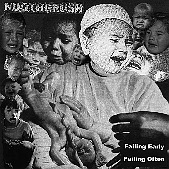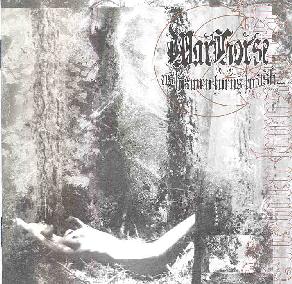
DivShare File - malignant_tumour-burn_in_hell-2005.zip
 Not everything but a good start on one of the best thrashy catchy punk bands ever.
Not everything but a good start on one of the best thrashy catchy punk bands ever. "A split release of massive proportions, this new 7 inch pairs 2 of the most volatile and original bands to emerge from hardcore punk in the last 10 years. Tokyo's Melt Banana (2 songs) should be familiar to anyone with a taste for the extreme, having released God-knows-how-many albums and singles on the likes of Skin Graft, Slap a Ham, A-Zap, HG Fact and others. The Locust (5 songs) are virtually a household name these days - suffice it to say a lot of kids will be chomping at the bit to get their filthy paws on this. It's also the band's first release as a 4-piece and the difference is remarkable - the 'blastbeat' now more of a form of punctuation than the whole basis for a song. Full color artwork by Sam McPheeters (Born Against, Men's Recovery Project) that will bring a smile to your face and a tear to your eye."
"A split release of massive proportions, this new 7 inch pairs 2 of the most volatile and original bands to emerge from hardcore punk in the last 10 years. Tokyo's Melt Banana (2 songs) should be familiar to anyone with a taste for the extreme, having released God-knows-how-many albums and singles on the likes of Skin Graft, Slap a Ham, A-Zap, HG Fact and others. The Locust (5 songs) are virtually a household name these days - suffice it to say a lot of kids will be chomping at the bit to get their filthy paws on this. It's also the band's first release as a 4-piece and the difference is remarkable - the 'blastbeat' now more of a form of punctuation than the whole basis for a song. Full color artwork by Sam McPheeters (Born Against, Men's Recovery Project) that will bring a smile to your face and a tear to your eye." DivShare File - schifosi_-_half_lit_world__2005_aborted_s.rar
DivShare File - schifosi_-_half_lit_world__2005_aborted_s.rar DivShare File - schifosi_-_absentium_existence.rar
DivShare File - schifosi_-_absentium_existence.rar

LINE UP
Danny Violence (vocals / guitar), Mieszko (vocals / guitar), Richard A.D. (vocals / bass), Matt von Superstar (drums)
Grindcore band formed during 1994 by guitarists Danny Violence and Mieszko, the latter of NASUM repute. The NECRONY and NASUM credited Richard A.D. handled bass. GENOCIDE SS evolved into a balls out Rock n' Roll band GENOCIDE SUPERSTARS for their third 2003 album 'Superstar Destroyer'.


| 1. | May Your God Deny You | 05:02 | |
| 2. | Occult Machinery | 03:29 | |
| 3. | Let Us Worship the Dead | 01:41 | |
| 4. | Serve the Adversary | 05:00 | |
| 5. | Agents of Destruction | 04:14 | |
| 6. | In Hatred and Misery | 06:32 | |
| 7. | The Dawn of Industry | 03:56 | |
| Total playing time | 29:54 | ||






Tracklisting:
| A1 | In The Spotlight (2:57) | |
| A2 | Dozen Summers Behind (2:36) | |
| B1 | Braces (3:06) | |
| B2 | Nippon Lolita Substitute (1:06) |
"1996-2003.
We sounded really bad at first, then we sounded better, then we didn't want to be in a hardcore band anymore. Isn't that always the case?
For the seven years Combat was around, we only were together in a practice room, at a show or in a studio together for a total of five months. After all was said and done we had two vocalists, two bass players, five guitar players, two drummers, one apperance by Jimmy Reese, one Hammond organ player, one remote control player, one inner band fist fight, one flirtation with Latin percussion and two solid instances of Norris insulting people's dead parents in a live setting.
NO we still do not want to be on your tape comp with Ulcer, Agathocles, Unholy Grave and Capitalist Casualties. NO we don't think we sounded like Charles Bronson or The Locust. YES we have seen Sam McPheeters artwork. And most importantly, NO WE ARE NOT BACK TOGETHER.



 First EP
First EP
| 1. Suspiria |
| 2. Witch |
| 3. Opening to the Sighs |
| 4. Sighs |
| 5. Markos |
| 6. Black Forest |
| 7. Blind Concert |
| 8. Death Valzer |
| 9. Suspiria [Celesta and Bells] |
| 10. Suspiria (Narration) |
| 11. Suspiria (Intro) |
| 12. Markos [Alternate Version] |




 Hellbastard - In Grind We Crust: http://www.divshare.com/download/625057-8c6
Hellbastard - In Grind We Crust: http://www.divshare.com/download/625057-8c6

"Nuclear Death were formed on March 23, 1986, by Laura Bravo (vocals, bass), Phil Hampton (guitar), and Joel Whitfield (drums). Their first demo, Wake Me When I'm Dead, was released later that same year, receiving positive reviews from American and overseas zines. They were notable as at the time very few thrash metal artists had female singers. Their second demo, Welcome to the Minds of the Morbid, followed in 1987, on the back of which Nuclear Death signed a contract with Richard Campos from Wild Rags, a record label, fanzine and record dealer in California.
In 1991, the band released their more controversial work, entitled Carrion for Worm, containing many songs considered to be in bad taste, such as "The Human Seed", "Lurker in the Closet: A 'Fairy' Tale", and "Greenflies". Carrion for Worm featured vocals by Chris Reifert, singer from popular death metal band Autopsy, on two songs, "Cathedral of Sleep" and "Vampirism".
On May 23, 1992, Nuclear Death played a notorious concert in Puerto Rico, with label partners Impetigo. Later that year they released For Our Dead, a four-track single containing a rerecorded version of 1987's "The Third Antichrist" from Welcome to the Minds of the Morbid.
After the break-up of Nuclear Death, Lori went on to form a new band, Raped, in 2002, and Phil Hampson and Joel Whitfield joined Eroticide."
 Failing Early, Failing Often: http://www.divshare.com/download/612171-c12
Failing Early, Failing Often: http://www.divshare.com/download/612171-c12
 http://www.divshare.com/download/611706-a27
http://www.divshare.com/download/611706-a27 jazzy tokyo skate thrash
jazzy tokyo skate thrash
The cover of Coffins' last album, Mortuary in Darkness, depicts a naked lady on her back in a cemetery, one of her legs held up by a bone-winged demon who's gnawing on her severed arm. Another demon lurks in the background with a bloody machete in one hand and a spine (with the skull still attached) in the other. Plus a few inverted crosses. The cover of The Other Side of Blasphemy has another unclothed woman spread-eagled in front of a demon. On this one, she's nailed to the ground with crosses and our guy is holding the demon baby he has obviously just ripped out of her womb. Oh, and there's a burning church in the background. This demon is bigger and clearly higher-ranked in the demon hierarchy than the Mortuary guys. In D&D, Blasphemy Demon could once per day summon 5-8 (1d4+4) of the Mortuary Demons; in a video game, he'd be a middle-of-the-game boss, and eventually you'd just kill the smaller ones for power-ups.
As a man with word count limitations, I'm happy to report that the albums are pretty much the same deal: The Other Side of Blasphemy is a meaner, more damaging big brother to Coffins' previous records. A t-shirt scan pulls up Hellhammer, Corrupted, and Grave, and the Tokyo trio nails the good parts of all of them. The tempos rarely rise above a crawl, except for the Frosty gallop in the first half of "Evil Infection," with "Destiny to Suffering" wallowing in the deepest sludge for seven-and-a-half minutes. It's still less muddy than Mortuary, and the slightly brighter recording gives Blasphemy an occult flamejob assisted by the increased presence of lead guitar. Which makes the melodic and triumphant (but still doomy as hell) instrumental "Rise" a surprising closer. I like to assume that it's the demon who was triumphant, and that he's flying the demon baby off to his even bigger master, where he'll be trained in demonic arts involving naked ladies and the saga will continue. —Anthony Bartkewicz
